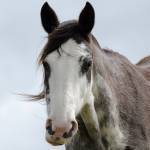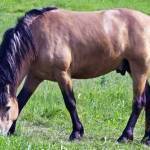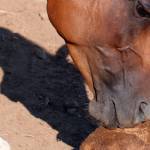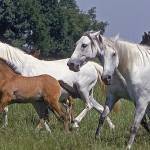Horse Too Skinny? Four Tips for Weight Gain

Horse owners frequently ask nutritionists how best to support weight gain in horses. In springtime, many horse owners realize their horses have dropped weight over the winter, and others are concerned that their horses don’t have enough condition to support top performance.
Select a Suitable Forage
“Very often, weight management comes down to a proper understanding of how to feed horses suitable types and amounts of forage and, if necessary, appropriate concentrates,” said Catherine Whitehouse, M.S., a nutritionist with Kentucky Equine Research.
First, evaluate the horse’s current diet. Always begin with forage. What kind of hay or pasture is available? If pasture is sparse or weedy, it is likely not providing sufficient nourishment or fiber. To provide adequate calories and nutrients, ensure that good-quality hay is available throughout the day. Forage sources should be free of debris. Grass hay, such as orchardgrass, fescue, timothy, or bermudagrass varieties, should not be overmature with a lot of stems or seed heads but instead should be “softer” with more blades of grass. Legume hay, such as alfalfa, is typically higher in energy, protein, and calcium than grass hay.
If possible, have an equine nutritionist or university equine extension specialist help you acquire and interpret a hay analysis to gauge the quality of the hay. This is especially important for some horses with metabolic conditions.
In addition to hay and pasture, forage alternatives, such as soaked beet pulp, hay cubes, and hay pellets, are quite useful for providing extra fiber that supports a healthy hindgut.
“Aside from forage quality, forage quantity is important. For horses that need to gain weight, free-choice consumption of forage is often allowed. At the least, the horse should be fed 1.5-2% of the desired body weight daily in good-quality forage,” said Whitehouse. “Near-constant forage availability supports a healthy gastrointestinal tract and overall well-being.”
Choose Appropriate Concentrates
Horses are often fed concentrates to boost calorie intake and supply nutrients not found in adequate amounts in forage. As their name suggests, concentrates are dense sources of calories. Examples of concentrates include grains (oats, for example), textured feed (also known as sweet feed), and pelleted feed. Considerations include:
- Is the product appropriate for the horse? Feed manufacturers often produce a line of feeds, each specifically tailored to a certain class of horse. General feed types include growth, performance, senior, or maintenance. “When a horse needs to gain weight, it is sometimes necessary to think outside of class. For instance, a horse at optimal weight exercised lightly a few times a week may maintain its weight on good-quality forage and the lowest recommended portion of maintenance feed,” explained Whitehouse. “The same horse, if underweight, may benefit from a performance feed, as it will provide more calories from several different energy sources, such as starch, fat, and fiber.”
- If the product is suitable for the horse, is it fed according to the manufacturer’s directions? If the horse is underfed, the calories and nutrients may not be sufficient for weight gain or optimal health.
- Does the product contain enough fat? Concentrates with higher fat (ranging from 10-14% crude fat) typically provide more calories per pound than maintenance feeds (often ranging from 3-6% crude fat). A slow changeover to a higher fat feed may be appropriate to support weight gain. Performance and senior feeds generally contain more fat than feeds intended for other classes of horses.
- How much exercise will the horse get? If the horse is training or competing, more energy (calories) will be expended during exercise, so those calories must be replaced to support weight gain.
Supporting weight gain often means that large amounts of concentrate are fed daily. To maximize the benefits of concentrate, consider feeding three or four small meals rather than one or two large meals. This feeding strategy keeps the gastrointestinal tract more content, minimizing the likelihood that starch leaves the small intestine undigested.
“When inadequate digestion of starch occurs in the small intestine, starch moves to the large intestine, where fermentation of starch can lead to hindgut acidosis,” explained Whitehouse. While hindgut acidosis can be alleviated by EquiShure, a research-proven hindgut buffer, it is best not to overwhelm the hindgut.
Identify High-Calorie Top-Dressings
In addition to appropriate forage and concentrate, adding oil or stabilized rice bran to the diet can boost the calorie density of a meal without adding excessive volume. When adding fat to a horse’s diet, it must be introduced slowly and increased slightly every 3-4 days. If a horse shows signs of inappetence, reduce the amount being fed and allow more time for the horse to adjust to the fat before increasing the amount.
Vegetable oil is palatable to most horses. Start with one-quarter cup (60 mL) or less and gradually add more as needed. Up to 2 cups (500 mL) of oil can be mixed into the concentrate to support weight gain. Some horses may find that much oil objectionable, and any leftovers must be cleaned from feeders to avoid rancidity and pests.
Stabilized rice bran is another popular and palatable fat supplement for horses. Like vegetable oil, stabilized rice bran is mixed into the concentrate before feeding. Feeding rates vary based on the brand, but 1-2 lb (0.5-0.9 kg) is the usual recommendation.
Several commercial fat supplements in the form of granules or extruded particles are available, and horses usually find these quite acceptable. Horses fed high-fat diets should be supplemented with a highly bioavailable natural-source vitamin E, such as Nano-E, for its antioxidant properties.
Gather Your Tools
When monitoring a horse’s weight, it is important to use a few key tools, including a camera, a weight tape or electronic scale, a body condition scorecard, and an inexpensive kitchen scale.
When you begin a horse’s weight-gain program, take a few profile photos from both sides. Set a reminder in your smartphone to snap new photos every time you weigh the horse. A visual reference is often needed to show progress.
Measuring weight is an objective way to document change and will also help determine when it is time to taper off feeding excess calories once the weight-gain goal has been achieved. Regular use of a weight tape is the most common method of tracking weight, though electronic scales are available and used extensively at breeding farms and larger performance centers. Weigh once every week or two weeks, and record the weight in the same place each time. While weight tapes may not accurately measure weight, they do a commendable job of tracking weight changes, especially when the handler is conscientious of positioning the tape at the same anatomical place each time and keeping tension consistent from one weighing to the next.
Use this body condition scorecard to help determine body condition. To appropriately assess body condition, both visual appraisal and hands-on evaluation are necessary. Keep the body condition score and any notes you make with the horse’s photos and current weight.
Use a simple kitchen or fishing scale to weigh concentrates and fat supplements. A “scoop” or “can” full of product is not an accurate way to measure intake. A scale can also be used to measure forage for a more accurate assessment of intake. Record changes in diet as they are made.
In summary, achieving weight gain takes time, so any temptation to rush the process should be reined in. Using good-quality forage and concentrate, fed at the appropriate amounts, is the place to start.








